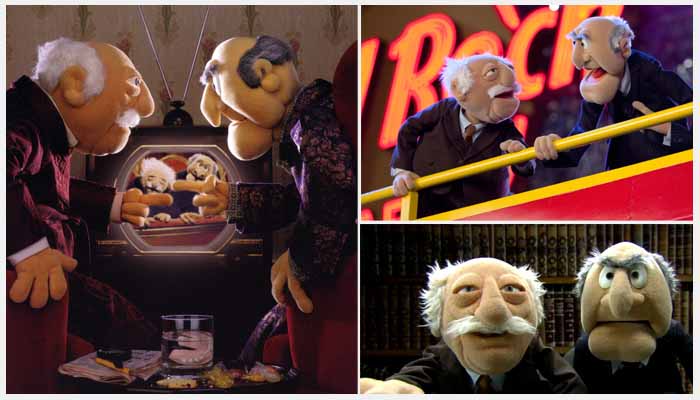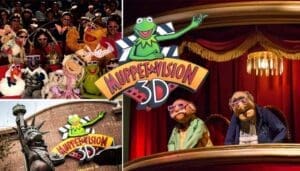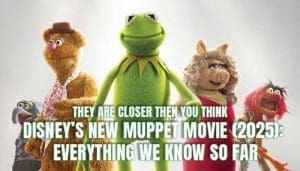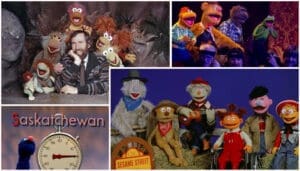Statler and Waldorf. The names themselves conjure images of two elderly gentlemen perched in a balcony, their voices a familiar chorus of witty disdain echoing through the Muppet Theater. Instantly recognizable as the resident curmudgeons of the Muppet universe, this dynamic duo has captivated audiences for decades with their sharp banter and hilariously pessimistic outlook. Their enduring popularity stems not just from their grumpy demeanor, but from their uncanny ability to articulate the thoughts many viewers might have while watching a less-than-stellar performance. This article delves into the origins, evolution, and lasting impact of these beloved hecklers.
Their journey began in 1975 with the pilot episode of The Muppet Show, aptly titled “Sex and Violence”. This initial foray into the world of variety entertainment, hosted by Kermit the Frog, introduced audiences to a vast array of memorable characters, but it was Statler and Waldorf who immediately established themselves as the show’s critical backbone. In this debut, Statler was brought to life by the vocal talents of Jerry Nelson, while the inimitable Jim Henson himself performed Waldorf. Interestingly, due to Nelson’s initial unavailability during the early weeks of production for the full series, Richard Hunt stepped into the role of Statler, a part he would famously hold for the majority of the show’s run. This early change in performers highlights the immediate recognition of the characters’ potential and the importance of establishing a consistent comedic pairing.
The concept for these iconic characters came from the creative minds of Jim Henson and designer Bonnie Erickson. Their names, a sophisticated touch, were inspired by two of New York City’s most prestigious hotels: the Statler Hilton and the Waldorf-Astoria. This naming choice adds a layer of irony to their roles as often unimpressed spectators of decidedly less-than-prestigious acts. Their physical appearances, too, are distinct: Statler, typically positioned to Waldorf’s right from the audience’s perspective , is characterized by his grey hair and eyebrows, while Waldorf sports a distinguished white mustache and hair. The inspiration for their comedic style likely draws from the rich history of vaudeville, particularly the tradition of “stooges” or planted hecklers in the audience. Some theories even suggest influences from comedian Irving Benson’s heckler character on The Milton Berle Show and the sharp, deadpan humor of the comedy duo Bob and Ray. These potential connections ground their comedic approach in established forms of entertainment, lending a timeless quality to their grumbling critiques.
From their prized seats in the balcony of the Muppet Theater, Statler and Waldorf’s primary function is to deliver a constant stream of negative opinions on the unfolding entertainment. No act is safe from their withering remarks, but Fozzie Bear, with his unwavering optimism and often-failing comedic aspirations, frequently finds himself the target of their sharpest barbs. Despite their seemingly perpetual dissatisfaction, a humorous irony lies in their own amusement at their jokes; they often erupt in hearty laughter at their own witty (in their opinion) observations. Adding to their unique dynamic is their tendency to break the fourth wall, directly addressing the audience and acknowledging their role as spectators within a show. Interestingly, Waldorf was once married to a woman named Astoria, who apparently bore a striking resemblance to Statler, and Statler himself has alluded to having been married multiple times. Perhaps one of the most enduring mysteries surrounding the duo is their consistent attendance at a show they so openly despise. As the theme song of The Muppet Show itself poses, “Why do we always come here?”. This unanswered question fuels fan speculation and adds to their enigmatic charm, with theories ranging from a secret enjoyment of the chaos to a simple need for something to complain about.
The humor of Statler and Waldorf has been met with overwhelmingly positive reviews from critics and has resonated deeply with audiences. Hadley Freeman of The Guardian lauded their “sharp banter,” even declaring them her “heroes”. Nick Schager of Esquire went so far as to name them among “The 10 Most Entertaining Fictional Critics,” stating unequivocally that they are “the funniest Muppets characters”. The Huffington Post noted their popularity, suggesting that fans who favor them appreciate the comedic value of laughing at someone else’s expense. Their impact extends beyond the screen, as commentators often draw parallels between real-life individuals known for their critical or cantankerous personalities and the balcony duo. However, this cultural comparison can sometimes be met with less enthusiasm, as evidenced by the uproar in British media when a German publication, Der Spiegel, likened the United Kingdom’s role in Europe to that of Statler and Waldorf. This incident underscores the power of their image as critical observers.
Throughout their time in the Muppet universe, Statler and Waldorf have been featured in numerous memorable sketches and productions. Their regular heckling during The Muppet Show became a signature element of the program. Beyond their balcony perch, they took on iconic roles, such as the hilariously grumpy ghosts of Jacob and Robert Marley in The Muppet Christmas Carol, where they continued their tradition of heckling, this time directed at Ebenezer Scrooge. In Muppet Treasure Island, they served as the bickering figureheads of the ship Hispaniola, proving their comedic dynamic could thrive even when they were part of the scenery. Recognizing their enduring appeal, they were even given their own web series, Statler and Waldorf: From the Balcony, where they applied their critical eye to the world of movies, reviewing trailers and offering their signature brand of commentary. Their cultural impact is further evidenced by their guest appearances in various non-Muppet media, including Weezer’s music video for “‘Keep Fishin'” and a memorable routine on The Tonight Show with Conan O’Brien where they heckled President Barack Obama. Their repertoire of memorable lines includes the classic exchange, “They’re not half bad.” “Nope, they’re ALL bad!” , and witty ponderings such as, “Do you think there’s life after death?” “Every time I leave this theater”. These recurring sketches and catchphrases have solidified their place in comedic history.
Statler and Waldorf’s impact on comedy extends beyond their own performances. They perfectly embody the archetype of the comedic heckler, a figure that has been a part of entertainment for centuries. Their style of humor draws from the traditions of vaudeville and stand-up comedy, where audience interaction, even if negative, was a common occurrence. By consistently breaking the fourth wall, they blur the traditional boundaries between performer and audience, inviting viewers into their cynical perspective. The characters were likely inspired by a lineage of comedic critics, including Irving Benson’s heckler character and the duo Bob and Ray, demonstrating how comedic ideas evolve and are reinterpreted across different generations. Their influence can be seen in the prevalence of the cynical observer in comedy and the continued use of their quotes in various contexts.
Across the vast Muppetverse, Statler and Waldorf have maintained a remarkably consistent portrayal as elderly, cynical hecklers. Their primary setting remains the balcony of the Muppet Theater in The Muppet Show. However, they have also appeared as adults in the animated series Muppet Babies, voiced by Dave Coulier. Their roles as the Marley ghosts in The Muppet Christmas Carol are a beloved iteration , as is their portrayal as the figureheads in Muppet Treasure Island. In the series Muppets Tonight, they were humorously relocated to an assisted living facility, yet their critical commentary remained as sharp as ever. Guests at Disney’s Hollywood Studios can even experience their heckling firsthand as audio-animatronic figures in Muppet*Vision 3D. They even made a cameo appearance in Pixar’s short film Presto, firmly situated in their familiar theater box. In the more recent Muppet films, The Muppets (2011) and Muppets Most Wanted (2014), they continued to deliver their signature critiques, even from Kermit’s old office and a run-down theater in Berlin. Their presence extended to the 2015-2016 The Muppets TV series as audience members , and, as mentioned, their web series Statler and Waldorf: From the Balcony further cemented their role as pop culture critics. Their numerous guest appearances in other shows and events, such as Family Guy, WWE Raw, and The Game Awards , highlight their widespread recognition and integration into popular culture.
The enduring appeal of Statler and Waldorf lies in a multitude of factors. Their sharp wit and clever one-liners are consistently entertaining. Many viewers find their cynical perspective relatable, as they often voice the unspoken criticisms that might cross one’s own mind while watching a performance. The comedic chemistry between the two characters is undeniable, with their back-and-forth banter creating a unique and hilarious dynamic. They serve as audience surrogates, humorously commenting on the often-absurd nature of the entertainment unfolding before them. Even their constant grumbling provides a form of comedic relief. Their impact is so significant that the term “Statler & Waldorf Syndrome” has even emerged to describe a pattern of chronic criticism without offering constructive help. The continued production of merchandise featuring the duo further attests to their lasting popularity.
In conclusion, Statler and Waldorf are more than just grumpy old men heckling from a balcony. They are an integral part of the Muppet Show’s DNA, embodying a timeless comedic archetype with sharp wit and undeniable charm. Their enduring legacy lies in their ability to make audiences laugh at the flaws and follies of performance, and perhaps even at themselves. These heckling heroes have cemented their place in the pantheon of comedic greats, continuing to bring joy and laughter to generations of viewers.
Performers of Statler and Waldorf Over Time
| Character | Performer(s) | Years of Performance (Key Productions) |
|---|---|---|
| Statler | Jerry Nelson, Richard Hunt, Steve Whitmire, Peter Linz, Drew Massey, Artie Esposito, Bill Barretta, Duncan Kenworthy | Jerry Nelson (1975, The Muppet Show: Sex and Violence, 1992-2003), Richard Hunt (1976-1991, The Muppet Show), Steve Whitmire (2002-2016), Peter Linz (2017-present), Drew Massey (2005-2006, Statler and Waldorf: From the Balcony), Artie Esposito (2009), Bill Barretta (2003, 2014), Duncan Kenworthy (1990) |
| Waldorf | Jim Henson, Dave Goelz, Jerry Nelson, John Lovelady, Craig Shemin, Kevin Clash, Victor Yerrid, Steve Whitmire | Jim Henson (1975-1990, The Muppet Show), Dave Goelz (1992-present), Jerry Nelson (1974), John Lovelady (1976), Craig Shemin (1990), Kevin Clash (1996, Muppets Tonight), Victor Yerrid (2005-2006, Statler and Waldorf: From the Balcony), Steve Whitmire (2011) |
Notable Appearances of Statler and Waldorf in Different Productions
| Production Title | Year(s) | Type | Role/Context |
|---|---|---|---|
| The Muppet Show | 1975-1981 | TV Series | Balcony hecklers |
| Muppet Babies | 1984-1991 | TV Series | Adults |
| The Muppet Christmas Carol | 1992 | Film | Ghosts of Jacob and Robert Marley |
| Muppet Treasure Island | 1996 | Film | Figureheads of the Hispaniola |
| Muppets Tonight | 1996-1998 | TV Series | Watching from an assisted living facility |
| Muppet*Vision 3D | 1991-2024 | Theme Park Ride | Audio-animatronic figures heckling the show |
| Presto | 2008 | Short Film | Cameo in their theater box |
| The Muppets | 2011 | Film | Featured roles in Kermit’s old office |
| Muppets Most Wanted | 2014 | Film | Scene in Berlin |
| The Muppets | 2015-2016 | TV Series | Audience members |
| Statler and Waldorf: From the Balcony | 2005-2006 | Web Series | Hosts, reviewing movies and trailers |
| Marvel Team-Up #74 | 1978 | Comic Book | Hecklers on a balcony |
| Weezer – ‘Keep Fishin” | 2002 | Music Video | Commenting on the performance |
| The Tonight Show with Conan O’Brien | 2009 | TV Show | Routine called “Statler and Waldorf Heckle Obama” |
| WWE Raw | 2011 | TV Show | Offering commentary from a skybox |
| Family Guy | Various | TV Series | Occasional cameos heckling various situations |
| The Game Awards | 2024 | Awards Show | Heckling the presenter |




